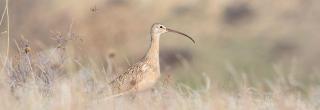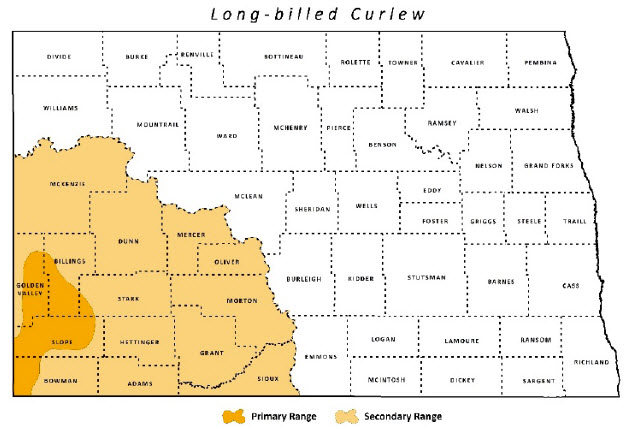
Long-Billed Curlew
| Scientific Name | Numenius americanus |
|---|---|
| General Description | L 23”, WS 35”, 1.3 lb. Long, down-curved inch bill, buffy overall with pink-cinnamon underwings visible in flight. |
| Status | Occurs in North Dakota from mid-April to August. Peak breeding season from early May to early July. |
| Abundance | Uncommon to rare. |
| Primary Habitat | Short-grass prairie or shrub steppe prairie on gently rolling terrain. |
| Federal Status | Migratory Bird. |
| Reason for Designation | Curlews numbered much higher during the 1800s and were more widely distributed, but the population appears to be more stable in recent years. It is included on the National USFWS Birds of Conservation Concern list, and also in Region 6, BCR 11 and 17. Watch List species in need of Management Attention in Shorebirds of Conservation Concern 2015. |
Locations and Conditions of Key Habitat
Preferred Habitat
For breeding, Long-billed Curlews use expansive, open, level to gently rolling or sloping grasslands of short vegetation such as short-grass and grazed mixed-grass prairie. Areas where the majority of the vegetation height is less than 10 cm are preferred. Proximity to water is possibly an important factor in habitat selection. Nest in the dry uplands near wet areas such as wet meadows, which are used for feeding, loafing, and by young fledglings. Forage in grassland, cultivated fields, stubble fields, and black-tailed prairie dog colonies for terrestrial invertebrates such as grasshoppers and beetles. Nests are usually located near cowpies or other conspicuous objects for concealment and are often on hummocks for improved visibility.
Key Areas and Conditions for Long-billed Curlew in North Dakota
No specific sites have been identified. Recent sightings come primarily from Slope, Bowman, southern Billings, southern Golden Valley, and western Stark counties.
Problems Which May Affect this Species
Habitat
Destruction and/or degradation of grassland habitat is the greatest threat to Long-billed Curlews in North Dakota.
Other Natural or Manmade Factors
Curlews are sensitive to disturbance from human activities, especially during the nesting and brood-rearing periods. Abandonment of breeding sites due to human disturbance has been documented. Expanding oil and gas development in North Dakota may impact Long-billed Curlews.
Research and Survey Efforts
Current Research or Surveys
- There is currently nothing specific to the species in North Dakota.
Previous Research or Surveys
- University of North Dakota (ND SWG T-6-R) determined the distribution and abundance of the Long-billed Curlew in southwestern North Dakota. The project was initiated in 2005 and continued through 2007. The researchers conducted the range-wide and intensive census surveys within the Long-billed Curlew range. Almost all curlew observations were concentrated in extreme southwest North Dakota (Ackerman 2007).
- A two-year, range-wide survey to determine curlew distribution and population was completed in 2004 and 2005.
Additional Research or Surveys Needed
- Ackerman 2007 recommended Long-billed Curlews should be fitted with radio/GPS transmitters to determine approximate home-range sizes, the importance of water within a breeding territory, migratory routes, and crucial stopover sites.
- The Status Assessment and Conservation Action Plan for the Long-billed Curlew contains a comprehensive list of potential action items.
Population and Trend Estimates
- North American Population Estimate 2012: 140,000
- 2005 and 2006 North Dakota estimate: 518 breeding Long-billed Curlews in 2005 and 2,074 breeding individuals in 2006.
- Survey-wide BBS Trend 1966-2012: 0.20
Management Recommendations
- Prevent conversion of native grassland.
- Remove tall, dense vegetation before nesting period by using haying and grazing.
- Use fire to remove shrub coverage and increase habitat openness.
- Do not drag hayfields to break up cowpies.
- Curlews have been documented successfully using fall-seed crops (i.e. winter wheat). Encourage producers to incorporate fall-seed crops into their rotations if within the Long-billed Curlew range.
- Reduce pesticide use on grasslands.
Monitoring Plans
Few BBS routes in North Dakota intersect with Long-billed Curlew range. The project described above included recommendations for long-term monitoring of Long-billed Curlews in North Dakota. Statewide and intensive census routes were established and may be revisited in future years. A shorebird monitoring plan should follow The International Shorebird Survey (ISS) Program for Regional and International Shorebird Monitoring (PRISM) and “Guidance for Developing and Implementing Effective Shorebird Surveys.”
2005-2015 Progress
The Long-billed Curlew remains a Level I Species of Conservation Priority. The Natural Resources Conservation Service has implemented Greater Sage-Grouse habitat restoration programs within areas of the Long-billed Curlew breeding range. The curlew is benefiting from these conservation efforts. The American Bird Conservancy is focusing no shortgrass prairie grassland conservation, including implementing fencing and native seed plantings on private lands in southwest North Dakota.

Note: A listing of works consulted when compiling the information on this page may be found in the 2015 State Wildlife Action Plan.
